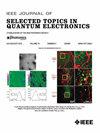带三级定时数字转换器的256 × 2 InGaAsP/InP盖革模式雪崩光电二极管阵列
IF 5.1
2区 工程技术
Q1 ENGINEERING, ELECTRICAL & ELECTRONIC
IEEE Journal of Selected Topics in Quantum Electronics
Pub Date : 2025-06-20
DOI:10.1109/JSTQE.2025.3581720
引用次数: 0
摘要
实现了256 × 2 InGaAsP/InP盖革模式雪崩光电二极管(GmAPD)阵列和带三级定时数字转换器(TDC)的匹配读出电路。像素在每帧的距离门内异步运行,允许测量最多三个反射激光回波的飞行时间。平均阵列定时精度为1ns,最小延迟时间(Thoff)为64ns。在1064 nm, - 20°C, Thoff为320 ns的平均光子探测效率(PDE)为33.1%的条件下,第一、第二和第三阶段TDC的平均暗计数率分别为2.5、1.0和0.5 kHz。累积后脉冲概率(APP)在- 20 ~ 20℃范围内表现出强烈的Vo-和Thoff依赖性,且对温度不敏感,在PDE为20%、Thoff为1 μs的条件下,累积后脉冲概率(APP)为15%。光子计数率的测量表明,在较短的Thoff下,光子阻塞和增加的后脉冲概率之间存在权衡。此外,还展示了三维激光点云和二维光子计数图像的并行获取能力,突出了该多tdc方案在强背景干扰下的主动和被动成像中的优势。本文章由计算机程序翻译,如有差异,请以英文原文为准。
256 × 2 InGaAsP/InP Geiger-Mode Avalanche Photodiode Arrays With a Triple-Stage Timing to Digital Converter
256 × 2 InGaAsP/InP Geiger-mode avalanche photodiode (GmAPD) arrays and a matched readout circuit with a triple-stage timing to digital converter (TDC) are realized. Pixels run asynchronously within the range gate of each frame, allowing measuring the time of flight of up to three reflected laser echoes. A mean array timing precision of 1 ns and a minimum hold-off time (Thoff) of 64 ns are achieved. The measured mean dark count rates are 2.5, 1.0 and 0.5 kHz for the first, the second and the third stage TDC, respectively, under a mean photon detection efficiency (PDE) of 33.1% at 1064 nm, −20 °C and a Thoff of 320 ns. While the cumulative afterpulsing probability (APP) exhibits strongly Vo- and Thoff-dependent behaviors and a temperature-insensitive nature from −20 °C to 20 °C, a cumulative APP of 15% is obtained under a PDE of 20% and a Thoff of 1 μs. Photon count rate measurements indicate trade-off between the photon blockage and the increased afterpulsing probability under shorter Thoff. Furthermore, capabilities of parallel acquirement of three-dimensional laser point cloud and two-dimensional photon count images are also demonstrated, highlights the superiorities of this multi-TDC scheme in both active and passive imaging under strong background interference.
求助全文
通过发布文献求助,成功后即可免费获取论文全文。
去求助
来源期刊

IEEE Journal of Selected Topics in Quantum Electronics
工程技术-工程:电子与电气
CiteScore
10.60
自引率
2.00%
发文量
212
审稿时长
3 months
期刊介绍:
Papers published in the IEEE Journal of Selected Topics in Quantum Electronics fall within the broad field of science and technology of quantum electronics of a device, subsystem, or system-oriented nature. Each issue is devoted to a specific topic within this broad spectrum. Announcements of the topical areas planned for future issues, along with deadlines for receipt of manuscripts, are published in this Journal and in the IEEE Journal of Quantum Electronics. Generally, the scope of manuscripts appropriate to this Journal is the same as that for the IEEE Journal of Quantum Electronics. Manuscripts are published that report original theoretical and/or experimental research results that advance the scientific and technological base of quantum electronics devices, systems, or applications. The Journal is dedicated toward publishing research results that advance the state of the art or add to the understanding of the generation, amplification, modulation, detection, waveguiding, or propagation characteristics of coherent electromagnetic radiation having sub-millimeter and shorter wavelengths. In order to be suitable for publication in this Journal, the content of manuscripts concerned with subject-related research must have a potential impact on advancing the technological base of quantum electronic devices, systems, and/or applications. Potential authors of subject-related research have the responsibility of pointing out this potential impact. System-oriented manuscripts must be concerned with systems that perform a function previously unavailable or that outperform previously established systems that did not use quantum electronic components or concepts. Tutorial and review papers are by invitation only.
 求助内容:
求助内容: 应助结果提醒方式:
应助结果提醒方式:


